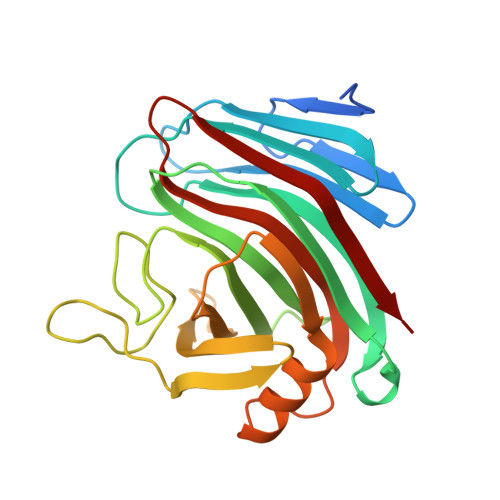Structural and enzymatic characterisation of the Type III effector NopAA (=GunA) from Sinorhizobium fredii USDA257 reveals a Xyloglucan hydrolase activity.
Dorival, J., Philys, S., Giuntini, E., Brailly, R., de Ruyck, J., Czjzek, M., Biondi, E., Bompard, C.(2020) Sci Rep 10: 9932-9932
- PubMed: 32555346
- DOI: https://doi.org/10.1038/s41598-020-67069-4
- Primary Citation of Related Structures:
6SDU - PubMed Abstract:
Rhizobia are nitrogen-fixing soil bacteria that can infect legume plants to establish root nodules symbiosis. To do that, a complex exchange of molecular signals occurs between plants and bacteria. Among them, rhizobial Nops (Nodulation outer proteins), secreted by a type III secretion system (T3SS) determine the host-specificity for efficient symbiosis with plant roots. Little is known about the molecular function of secreted Nops (also called effectors (T3E)) and their role in the symbiosis process. We performed the structure-function characterization of NopAA, a T3E from Sinorhizobium fredii by using a combination of X-ray crystallography, biochemical and biophysical approaches. This work displays for the first time a complete structural and biochemical characterization of a symbiotic T3E. Our results showed that NopAA has a catalytic domain with xyloglucanase activity extended by a N-terminal unfolded secretion domain that allows its secretion. We proposed that these original structural properties combined with the specificity of NopAA toward xyloglucan, a key component of root cell wall which is also secreted by roots in the soil, can give NopAA a strategic position to participate in recognition between bacteria and plant roots and to intervene in nodulation process.
Organizational Affiliation:
Sorbonne Université, CNRS, Integrative Biology of Marine Models (LBI2M), Station Biologique de Roscoff (SBR), 29680, Roscoff, Bretagne, France.

















